For many years deer ticks were isolated on the east side of the Hudson River. But now, deer ticks have crossed the river and they can be found in the Catskill Mountains. The major problem with ticks is that they can carry a variety of diseases, such as, Lyme Disease, Rocky Mountain Spotted Fever, and Anaplasmosis.
Lyme Disease - was the first disease carried by deer ticks to arrive in the Catskill Mountains around 2012. Lyme Disease is carried by Deer Ticks, and is transmitted to humans after they have attached themselves to a person for a prolonged period of time. If you are bitten by a deer tick, which is carrying the Lyme, you will feel like you are getting sick from a cold or flu. The incubation period is 3-30 days. Those symptoms are: Fatigue, fever, chills, headache, joint pain, etc. Sometimes you may get a "bulls-eye" rash anywhere from 5-30 days after being bitten. If untreated, the Lyme disease does not go away. Late stage symptoms are: Joint pain, nervous system issues, headaches, stiff neck, and sometimes heart beat irregularities. Most people are treated with a moderate antibiotic: doxycycline. You can encounter a deer tick any month of the year. Between the months of May and August, you will see very high populations of deer ticks. Deer ticks will stay active until the temperature drops to 22F or lower. Once below 22 degrees they will stay in the leaves on the ground until it warms up.
Rocky Mountain Spotted Fever - was first discovered in the Catskill Mountains around 2017. It is carried by the Dog Tick, and is transmitted to humans after they have attached themselves to a person for a prolonged period of time. The incubation period is 3-12 days. If you are bitten by a dog tick, which is carrying Rocky Mountain Spotted Fever, you will have a small solid colored rash about the size of a dime for a few days. Then you will develop a spotted or speculated rash that is quite large. Within another day or two it will cover a good portion of your body. Sometime thereafter, you will die. This is a serious disease and you should seek immediate medical care once you develop a spotted or speculated rash. If you cannot see your doctor within a reasonable amount of time, you should seek out an Urgent Care or Hospital Emergency Room. This disease is usually treated with doxycycline.
Anaplasmosis - was first discovered in the Catskill Mountains around 2018. It is carried by the Deer Tick, and is transmitted to humans after they have attached themselves to a person for a prolonged period of time. The incubation period is 5-14 days. Early symptoms resemble the Flu. More specifically you may experience some of these symptoms: Fever, chills, rigors, Severe headache, Malaise, Myalgia, Gastrointestinal symptoms (nausea, vomiting, diarrhea, anorexia), and in about 10% of the cases, you may have a rash. Every case has different symptoms. If the infected person attempts to "ride-out" what they consider the flu, they usually end up with organ failure, collapse from low blood pressure, and then shortly after, death. This is a serious disease and you should seek immediate medical care once you develop what appears to be a flu after bitten by a deer tick. If you cannot see your doctor within a reasonable amount of time, you should seek out an Urgent Care or Hospital Emergency Room. You can die very quickly from this disease! This disease is usually treated with doxycycline. Recovery from Anaplasmsis can take a significant amount of time to recover.
How to Prepare for being bitten by a Tick - If you are a hikers, you should always carry an old pill bottle with a cotton ball. It is also a good idea to carry a pair of tweezers for removing small nymphs. If you are bitten by a tick, you want to save the tick for testing in case you become sick, or suspect that you might have contracted a tick-borne disease.
How to Remove a tick - In the past, the method most commonly used to remove a tick was with a pair of tweezers. For small nymph ticks, tweezers are still the preferred method. But, for adults, there is a new method that works very well. The first step is to remove the cotton ball from the pill bottle. Leave the cap off the pill bottle.
Male deer ticks are black in color and they are slightly smaller then the Females. Females are black and red and they are slightly larger then the Males. They are very small and about the size of a pin head. They are very easy to miss. After hiking, you need to carefully search your body for deer ticks. Look for very small black spot. Inspect your entire body carefully. Make sure you check your armpits, scalp, and groin. Remove ticks from your clothes before going indoors. To kill ticks that you may have missed, wash your clothes with hot water and dry them in a dryer.
Deer ticks prefer wooded and areas with bushs. They also prefer areas with high grass and a lot of leaves. They are most active in May, June, and July. If you do enter an area that has a lot of deer ticks, walk in the center of the trail to avoid contact with overgrown grass, brush, and leaf litter.
Use insect repellent with at least 20% - 30% DEET on exposed skin and clothing. In cooler weather you should wear light colored long pants and shirts. Light-colored clothing will help you spot ticks more easily. Long socks helps to keep ticks off your skin.
If you discover a deer tick on your body remove it with a pair of tweezers. Look for the picture on right for the correct technique to remove a deer tick. If a tick is attached to your skin for less than 24 hours, your chance of getting Lyme disease is extremely small. But just to be safe, monitor your health closely after a tick bite and be alert for any symptoms.
Not all patients with Lyme disease will have all symptoms, and many of the symptoms can occur with other diseases as well. If you believe you may have Lyme disease, it is important that you consult your doctor for a proper diagnosis. Doctors usually will perform a simple blood test to determine if you are infected. The first sign of infection is usually a circular rash called erythema migrans ("EM"). This rash occurs in approximately 70-80% of infected persons and begins at the site of a tick bite after a delay of 3-30 days. A distinctive feature of the rash is that it gradually expands over a period of several days, reaching up to 12 inches (30 cm) across. The center of the rash may clear as it enlarges, resulting in a bull's-eye appearance. It may be warm but is not usually painful. Some patients develop additional EM lesions in other areas of the body after several days. Patients also experience symptoms of fatigue, chills, fever, headache, and muscle and joint aches, and swollen lymph nodes. Simple antibiotics can cure the disease. A small percentage of people have a problem with curing the disease. The sooner you start antibiotics, the better your chances of curing Lyme Disease.
Most patients can be cured with a few weeks of antibiotics taken by mouth. Antibiotics commonly used for oral treatment include doxycycline, amoxicillin, or cefuroxime axetil. Patients with certain neurological or cardiac forms of illness may require intravenous treatment with drugs such as ceftriaxone or penicillin. Patients treated with antibiotics in the early stages of the infection usually recover rapidly and completely. A few patients, particularly those diagnosed with later stages of disease, may have persistent or recurrent symptoms. The authors of studies sponsored by the National Institutes of Health have concluded that these patients may benefit from a second 4-week course of therapy and that longer courses of antibiotic treatment are not beneficial. Longer courses of antibiotics have been linked to serious complications, including death. Studies of women infected during pregnancy have found that there are no negative effects on the fetus if the mother receives appropriate antibiotic treatment for her Lyme disease.
If you find a deer tick attached to your body, you might consider saving the deer tick in a vial.
If left untreated, the infection may spread to other parts of the body within a few days to weeks, producing an array of discrete symptoms. These include loss of muscle tone on one or both sides of the face (called facial or "Bell's palsy), severe headaches and neck stiffness due to meningitis, shooting pains that may interfere with sleep, heart palpitations and dizziness due to changes in heartbeat, and pain that moves from joint to joint. Many of these symptoms will resolve, even without treatment. After several months, approximately 60% of patients with untreated infection will begin to have intermittent bouts of arthritis, with severe joint pain and swelling. Large joints are most often affected, particularly the knees. In addition, up to 5% of untreated patients may develop chronic neurological complaints months to years after infection. These include shooting pains, numbness or tingling in the hands or feet, and problems with concentration and short term memory.
If you have more question about Lyme disease, you can Email the CDC at cdcinfo@cdc.gov or call us at 1-800-CDC-INFO (232-4636).
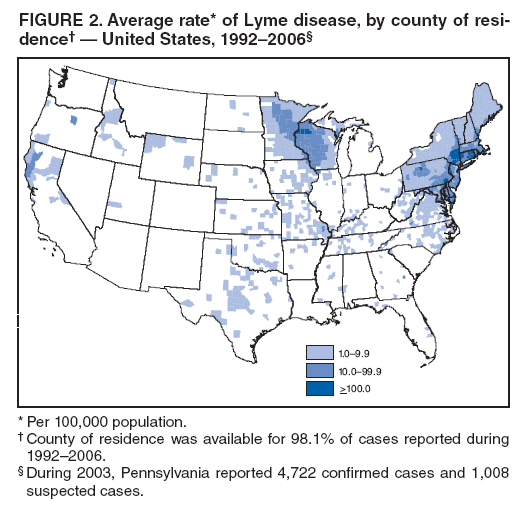
|
 |
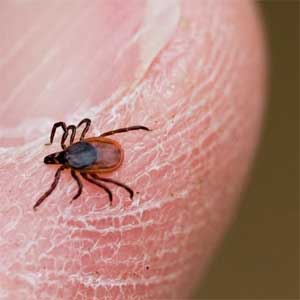 |
 |
Female Deer Tick |
 |
 |
 |
Male & Female Deer Tick |
 |
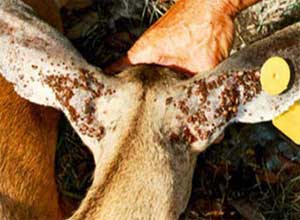 |
 |
Deer infested with Deer Ticks |
 |
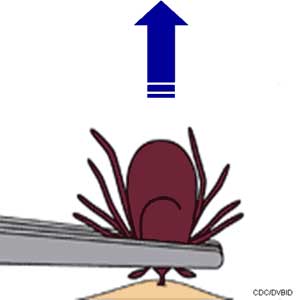 |
 |
How to remove a deer tick |
 |
 |
 |
Lyme disease with bullseye rash |
 |
 |
 |
Male & Female Deer Ticks |
 |
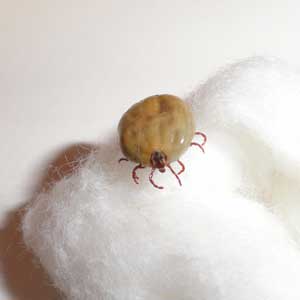 |
 |
Dog Tick after 4 days of feeding |
 |
 |
 |
Rocky Mountain Spotted Fever
6 days after initial Dog Tick bite
Dog Tick feed for 4 days |
 |
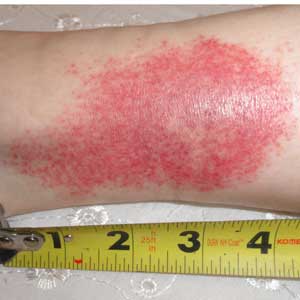 |
 |
Rocky Mountain Spotted Fever
9 days after initial Dog Tick bite
Dog Tick feed for 4 days
This is the Speculated Rash (Rare |
|

